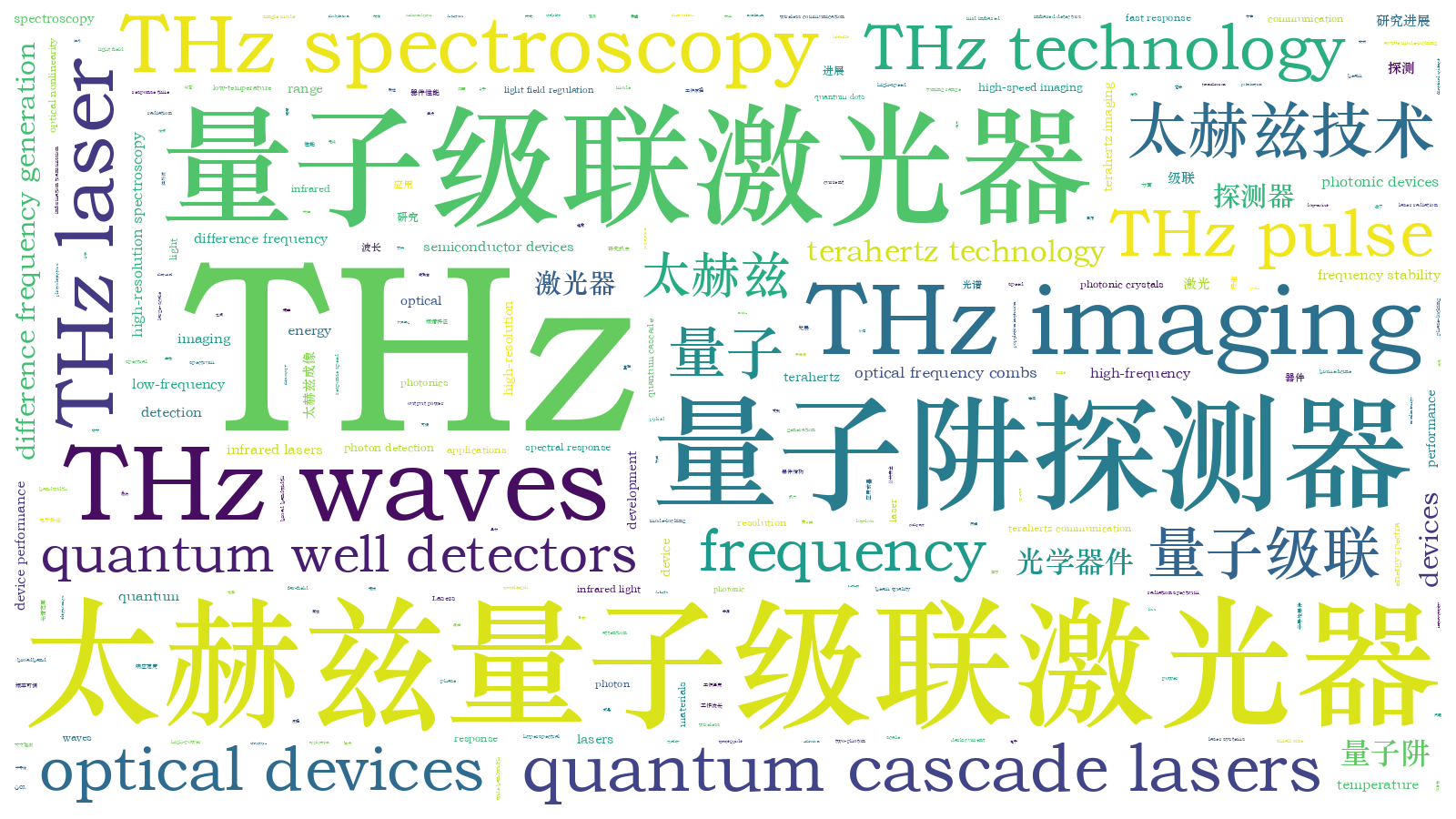太赫兹量子级联激光器与量子阱探测器研究进展(特邀)创刊五十周年特邀
Generally, the terahertz (THz) radiation spectrum is defined as the electromagnetic spectrum between 100 GHz to 30 THz (wavelength of 3 mm‒10 μm). THz waves have a wide bandwidth and low photon energy, their energy spectra cover the vibrational-rotational characteristics of numerous molecules, and THz waves can penetrate many non-polar media. These properties make them attractive for astronomical observations, public safety, biomedicine, and wireless communication. According to the different generation and detection methods of THz waves, THz technology can be divided into two categories: one is based on electronic technology-mainly related to microwaves in the low-frequency THz band, and the other is based on optical and photonics technology-mainly related to infrared light at higher frequencies. Further technical developments will bridge the gap between electronics and optics, enabling new THz spectroscopy and imaging methods for scientific exploration in physics, chemistry, biology, materials, devices, engineering, and other interdisciplinary fields.
Terahertz quantum cascade lasers (THz QCLs) and terahertz quantum-well photodetectors (THz QWPs) are semiconductor devices based on electron transitions within subbands. These devices are advantageous due to their small size, adjustable frequency, and fast response time. Over the past few years, their performance has improved and many techniques related to high-resolution spectroscopy, terahertz imaging, and wireless broadband communication have received considerable attention. Here, we review recent advances and discuss future research directions.
THz QCLs are the only practical and compact laser systems at this frequency and have significant impacts on the THz field. The first THz QCL was developed in 2002. After more than 20 years of development, device performance has made significant progress, including the emission frequency range from 1.2 THz to 5.6 THz, the maximum output power of 2.4 W, a single mode continuously tuning range of 650 GHz, a broad bandwidth of 2.6 THz, the maximum operating temperature of 261 K, and a great improvement in far-field beam quality (Figs. 3 and 4). The development of phase-locking technology has significantly improved the frequency stability of lasers, with the linewidth reaching a quantum limit of 100 Hz. This technology has been employed in high-resolution spectroscopy (Figs. 8 and 9). THz QCLs exhibit strong optical nonlinearity and short inter-subband transition lifetime, resulting in various applications. Room-temperature THz laser radiation is demonstrated through intra-cavity difference frequency generation in mid infrared lasers. Moreover, scientists have achieved active mode-locking, optical frequency combs, high-order wave mixing, inter-subband plasmons, and fast modulation and detection. These technologies have also been successfully used in metrology and THz imaging (Figs. 10 and 11).
THz QWPs are an extension of quantum-well infrared detectors to the THz band, with advantages such as fast response speed and small size. In 2004, the first THz QWP was successfully developed with a central detection frequency of 7.1 THz. Subsequently, by adjusting the energy of inter-subband transitions, the spectral response of THz QWP gradually covered the range of 1.5‒7.5 THz and 8.8‒15.0 THz. However, it is well documented that THz QWPs require low-temperature conditions, usually below 10 K, because the thermally activated current can rapidly exceed the photocurrent at high temperatures. Recently, the combination of device structure and metamaterials has effectively increased the operating temperature of the device to 60 K (Fig.7). In terms of applications, high-speed imaging and information transmission are demonstrated in the THz QCL and THz QWP systems (Fig.12), and THz QWPs are also used in broadband spectral measurements and nonlinear two-photon detection.
THz QCLs and THz QWPs have a significant impact on the THz field; however, their large-scale applications have not been realized. Currently, improving the high-temperature performance of devices is one of the main challenges because thermally excited carriers can obtain sufficient kinetic energy for transport between subbands at high temperatures. THz QCLs demolish the population inversion, whereas THz QWPs lead to an increase in the dark current. Additionally, a further increase in the frequency range poses challenges. Expanding to the low-frequency side becomes increasingly difficult owing to further reduction in photon energy, whereas expanding to the high-frequency side is limited by the reststrahlen band. The investigation of new active region designs, low-loss waveguide materials, metasurface structures, and photonic crystals is expected to improve the device performance. Moreover, wide-bandgap materials such as GeSi and quantum dots can be chosen for high-temperature devices. Additionally, high-power and low-noise optical frequency combs and ultrashort THz pulse technology have garnered considerable attention. Notably, understanding the phase relationship between the comb teeth and the mechanisms of pulsed operation can be helpful. Saturation absorbers based on inter-subband polaritons and harmonic combs have also been presented. THz QCLs with topological structures have opened up new directions. Topological structures result in unidirectional propagation of light, immunity to defects, and high-order light field regulation. Topological protection can facilitate the development of robust laser arrays, and topological chirality can modify far-field beam patterns and polarization for novel photonic devices.
The application and commercialization of THz QCLs and THz QWPs will become a driving force for the development of new methods for high-resolution spectroscopy, hyperspectral imaging, and terahertz communication. THz QCLs and THz QWPs combined with near-field microscopy can be employed for nanometer scale detection and used in fields such as material science and biomedicine.
曹俊诚, 韩英军. 太赫兹量子级联激光器与量子阱探测器研究进展(特邀)[J]. 中国激光, 2024, 51(1): 0114001. Juncheng Cao, Yingjun Han. Recent Progress in Terahertz Quantum Cascade Lasers and Quantum Well Detectors (Invited)[J]. Chinese Journal of Lasers, 2024, 51(1): 0114001.







